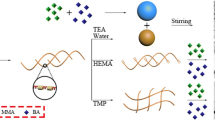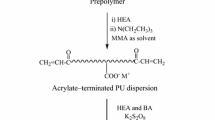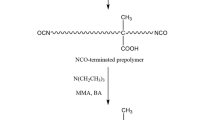Abstract
Hydroxyl acrylate emulsion was prepared firstly by the semicontinuous seeded emulsion polymerization, and then adding polyaniline (PANI)/Cu/ZrO2 ternary nanocomposites, two-component waterborne polyurethane (2 K WPU) composite coatings with antistatic and antibacterial properties were obtained by mixing the emulsion with hydrophilic modified polyisocyanate. The structure and morphology of the PANI/Cu/ZrO2 were observed by Fourier transform infrared spectroscopy, scanning electron microscopy, and X-ray diffractometer. The thermal, antistatic, antibacterial, anticorrosion, and mechanical properties of the 2 K WPU composite coatings were determined. The results showed that the addition of the ternary nanocomposites increased the antistatic, antibacterial, anticorrosion, and mechanical properties of the 2 K WPU coating. The initial decomposition temperature increased from 200 to 225°C, and the tensile strength increased by 44.4%. The coatings still maintained good impact strength of 50/50 kg cm, adhesion of grade 2, flexibility of 1 mm, pendulum hardness of 293 s, and the gloss (60°) of 119.4.














Similar content being viewed by others
References
Akbarian, M, Olya, ME, Ataeefard, M, Mahdavian, M, “The Influence of Nanosilver on Thermal and Antibacterial Properties of a 2 K Waterborne Polyurethane Coating.” Prog. Org. Coat, 75 (4) 344–348 (2012)
Ansari, MO, Mohammad, F, “Thermal Stability, Electrical Conductivity and Ammonia Sensing Studies on p-Toluenesulfonic Acid Doped Polyaniline: Titanium Dioxide (pTSA/Pani:TiO2) Nanocomposites.” Sensors Actuators B: Chem., 157 (1) 122–129 (2011)
Anju, C, Palatty, S, “Ternary Doped Polyaniline-metal Nanocomposite as High Performance Supercapacitive Material.” Electrochim. Acta, 299 626–635 (2019)
Chatterjee, AK, Chakraborty, R, Basu, T, “Mechanism of Antibacterial Activity of Copper Nanoparticles.” Nanotechnology, 25 (13) 135101 (2014)
Cloutier, M, Mantovani, D, Rosei, F, “Antibacterial Coatings: Challenges, Perspectives, and Opportunities.” Trends Biotechnol., 33 (11) 637–652 (2015)
Cheng, X, Kumar, V, Yokozeki, T, Goto, T, Takahashi, T, Koyanagi, J, Wu, L, Wang, R, “Highly Conductive Graphene Oxide/Polyaniline Hybrid Polymer Nanocomposites with Simultaneously Improved Mechanical Properties.” Comp. Part A, 82 100–107 (2016)
Dhonde, M, Sahu, K, Murty, VVS, Nemala, SS, Bhargava, P, “Surface Plasmon Resonance Effect of Cu Nanoparticles in a Dye Sensitized Solar Cell.” Electrochim. Acta, 249 89–95 (2017)
Fayemi, OE, Adekunle, AS, Swamy, BEK, Ebenso, EE, “Electrochemical Sensor for the Detection of Dopamine in Real Samples Using Polyaniline/NiO, ZnO, and Fe3O4 Nanocomposites on Glassy Carbon Electrode.” J. Electroanal. Chem., 818 236–249 (2018)
Bogdanović, U, Vodnik, V, Mitrić, M, Dimitrijević, S, Škapin, SD, Žunič, V, Budimir, M, Stoiljković, M, “Nanomaterial with High Antimicrobial Efficacy-Copper/Polyaniline Nanocomposite.” ACS Appl. Mater. Interfaces, 7 (3) 1955–1966 (2015)
Spanhel, L, “Colloidal ZnO Nanostructures and Functional Coatings: A Survey.” J. Sol-Gel Sci. Technol., 39 (1) 7–24 (2006)
Al-Shabander, BM, Kareem, AA, “The Effect of Zirconium Dioxide on Dielectric Properties and Thermal Conductivity of Polymers.” Int. J. Res. Mech. Mater. Eng., 1 (1) 15–18 (2015)
Yousefi E, Dolati A, Najafkhani H, "Preparation of Robust Antistatic Waterborne Polyurethane Coating." Prog. Org. Coat, 139 (2020)
Gizdavic-Nikolaidis, MR, Pagnon, JC, Ali, N, Sum, R, Davies, N, Roddam, LF, Ambrose, M, “Functionalized Polyanilines Disrupt Pseudomonas aeruginosa and Staphylococcus aureus Biofilms.” Colloids Surf. B-Biointerf., 136 666–673 (2015)
Geilich, BM, van de Ven, AL, Singleton, GL, Sepúlveda, LJ, Sridhar, S, Webster, TJ, “Silver Nanoparticle-embedded Polymersome Nanocarriers for the Treatment of Antibiotic-Resistant Infections.” Nanoscale, 7 (8) 3511–3519 (2015)
Armelin, E, Aleman, C, Iribarren, JI, “Anticorrosion Performances of Epoxy Coatings Modified with Polyaniline: A Comparison Between the Emeraldine Base and Salt Forms.” Prog. Org. Coat, 65 (1) 88–93 (2009)
Chen, Y, Wang, XH, Li, J, Lu, JL, Wang, FS, “Long-term Anticorrosion Behaviour of Polyaniline on Mild Steel.” Corrosion Sci., 49 (7) 3052–3063 (2007)
Chu, D, Wang, J, Han, Y, Ma, Q, Wang, Z, “High Performance Epoxy Protective Coatings Incorporated with Polyaniline Nanowires Using Cardanol-Based Phenalkamine as the Curing Agent.” RSC Adv., 5 (15) 11378–11384 (2015)
Akbarinezhad, E, Ebrahimi, M, Faridi, HR, “Corrosion Inhibition of Steel in Sodium Chloride Solution by Undoped Polyaniline Epoxy Blend Coating.” Prog. Org. Coat, 64 (4) 361–364 (2009)
Author information
Authors and Affiliations
Corresponding author
Ethics declarations
Conflict of interest
The authors declare that they have no known competing financial interests or personal relationships that could have appeared to influence the work reported in this paper.
Additional information
Publisher's Note
Springer Nature remains neutral with regard to jurisdictional claims in published maps and institutional affiliations.
Rights and permissions
Springer Nature or its licensor holds exclusive rights to this article under a publishing agreement with the author(s) or other rightsholder(s); author self-archiving of the accepted manuscript version of this article is solely governed by the terms of such publishing agreement and applicable law.
About this article
Cite this article
Li, X., Xu, X. & Zhang, F. Antistatic and antibacterial two-component waterborne polyurethane coating. J Coat Technol Res 20, 869–881 (2023). https://doi.org/10.1007/s11998-022-00708-9
Received:
Revised:
Accepted:
Published:
Issue Date:
DOI: https://doi.org/10.1007/s11998-022-00708-9




